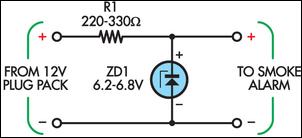Home » Circuits
Low-Cost Low-Intensity Alarm
Ever needed an alarm to monitor something but you didn't want to annoy the neighbours or scare the hell out of the family in the middle of the night? Using a feature found in most smoke alarms these days, this little circuit may do the trick for you. When the 9V battery level drops to about 7.4V in most smoke alarms, they emit a brief chirp at around 40 second intervals. In most cases, this is enough to attract attention, without the likelihood of waking the whole household. In effect, this circuit simply powers the smoke alarm at 6.8V, as derived from a zener diode (ZD1), so that it sounds its low battery warning. Apart from the zener diode, the smoke alarm draws only a few microamps, with a brief current spike during the "chirp". Smoke alarms are now very cheap to buy so this is a good alternative to a piezo siren.Circuit diagram:
More information on a common Smoke Alarm chip made by Motorola can be obtained at: http://e-www.motorola.com/files/sensors/doc/data_sheet/MC14467-1.pdf

